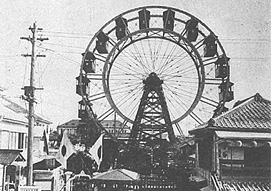Column <Tokyo>
7 Asakusa Hanayashiki: Transformation from a Park to an Amusement Park
The Japanese word "hanayashiki" was originally used in reference to public flower gardens (hana means flower) (Nihon Kokugo Daijiten. Shogakukan, 2000-2002). Mukojima Hyakkaen (in Sumida-ku (Sumida Ward), Tokyo), which faces Asakusa Hanayashiki on the opposite bank of the Sumida River, has since old times been known as a "hanayashiki" and is, in fact, still visited for its spectacular floral displays.
Asakusa Hanayashiki was also a well-known flower garden opened by a gardener named Morita Rokusaburo during the Kaei era (1848-1854) at the end of the Edo period (1603-1867).
These days, however, hanayashiki to most people refers to an amusement park and Asakusa Hanayashiki is thought to be Japan's first modern amusement park. The photo shows Asakusa Hanayashiki in Asakusa Park around 1907, when its transformation from a garden into an amusement park was already under way.
n fact, the revamp began as early as the start of the Meiji era (1868-1912), with "exercise machines" installed around 1872 and pavilions, including Omeganekan, opening in 1883. Asakusa Hanayashiki, however, was fully transformed into an amusement park over the period from 1887 to 1896 by Yamamoto Kinzo, a young lumber dealer in his 20s and manager of the park. (Kinzo is also the father of famed journalist Hasegawa Nyozekan).
In 1887, a five-story pavilion named Ozankaku (Hookaku) was transferred to Asakusa Hanayashiki from elsewhere in the city and was opened to the public the following year. This structure, until its collapse in the 1923 Great Kanto Earthquake, was extremely popular among sightseers as a "skyscraper" rivaling Asakusa Junikai (Ryounkaku) , which opened in 1890. In 1889, a diorama display gallery was additionally constructed in Asakusa Hanayashiki. The various dioramas showed historical scenes, such as the ceremony to promulgate the Constitution of the Empire of Japan. In 1890, a gramophone was installed at Ozankaku as a way of attracting more visitors to the park. It is said that a merry-go-round and dolls made of chrysanthemums were also placed within the park. These facilities contributed greatly to the park's transformation from a public garden to a full-blown amusement park.*
With all its addition and alterations, Asakusa Hanayashiki soon came to be considered the top entertainment spot in Asakusa Park.
"Hanayashiki, located in the fifth district of the park, is the No. 1 entertainment place in the park. In the past, Hayanashiki was a mere garden but its management, thinking it difficult to make a profit from operating a simple park, installed a gramophone and imported rare animals from overseas countries to show them to visitors. The park then soon grew in popularity." (Shinjigyo Hakkenho)
In the park's sixth district adjacent to Asakusa Hanayashiki, a first-generation Ferris wheel was transferred from the site of a trade fair held in Tokyo in 1907. Theaters for plays and movies were also constructed. Together with this sixth district of Asakusa Park, Asakusa Hayanashiki prospered as Japan's first amusement park.
* During the Meiji era, the word yuen was used as translation for park (Meiji no Kotoba Jiten). At present, yuenchi(amusement park) is defined as a park with amusement and entertainment facilities.
Reference
- Ozawa Emiko, Edokko to Asakusa Hanayashiki: Ganso Theme Park Funsen no Kiseki, Shogakukan, 2006 【DK261-H379】
- Meiji News Jiten, Mainichi Communications, 1983-1986 【GB8-116】
- Ogi Shinzo et al. (ed.), Edo Tokyogaku Jiten, Sanseido, 1988 【GB8-E10】
- Nihon Kokugo Daijiten, Shogakukan, 2000-2002 【KF3-G103】
- Sogo Masaaki and Hida Yoshifumi (ed.), Meiji no Kotoba Jiten, Tokyodo Shuppan, 1986 【KF7-77】
- Iwasaki Sodo, Shinjigyo Hakkenho, Daigakukan, 1903 【96-260】
